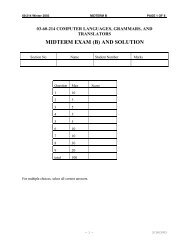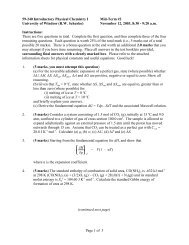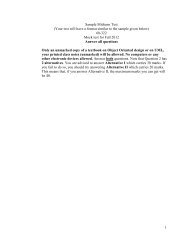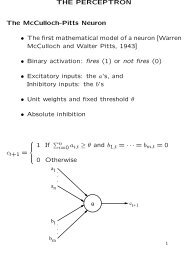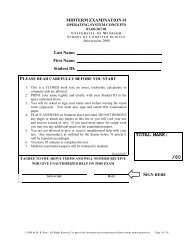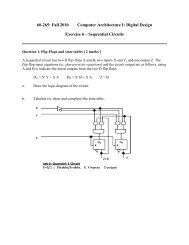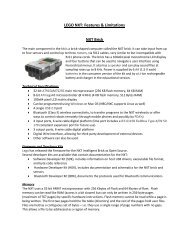LEGO NXT: Features & Limitations
LEGO NXT: Features & Limitations
LEGO NXT: Features & Limitations
You also want an ePaper? Increase the reach of your titles
YUMPU automatically turns print PDFs into web optimized ePapers that Google loves.
sound level that the sound sensor can determine is 90 dB (about the level of a lawnmower). It can hearsamples between 20 and 30 Hz (not fast enough to recognize human speech).The sound sensor definitely provides exciting possibilities for <strong>NXT</strong> robots. One of the simplestapplications is a sound-activated robot that begins to operate and/or stops operating upon hearing aloud sound (such as a verbal command). Another possibility is a robot that attempts to escape fromsound by finding a more peaceful spot.Digital SensorsThe <strong>NXT</strong> set includes three types of Digital Sensors: the ultrasonic sensor, the colour sensor and rotationsensors. An <strong>NXT</strong> digital sensor has two important characteristics. It has its own microcontroller, whichenables the sensor to take readings of its environment itself (as opposed to the <strong>NXT</strong> doing it), and itsends its data to the <strong>NXT</strong> using I 2 C communication, which allows the sensor to operate independentlyand transmit only its readings to the <strong>NXT</strong>.Ultrasonic SensorThe Ultrasonic Sensor is one of the three sensors that give your robot vision [The Light Sensor and ColorSensor are the others]. The Ultrasonic Sensor enables your robot to see and detect objects. You can alsouse it to make your robot avoid obstacles, sense andmeasure distance, and detect movement.The Ultrasonic Sensor measures distance in centimetres andin inches. It is able to measure distances from 0 to 255centimetres with a precision of +/- 3 cm.The Ultrasonic Sensor uses the same scientific principle as bats: it measures distance by calculating thetime it takes for a sound wave to hit an object and return – just like an echo. Large sized objects withhard surfaces return the best readings. Objects made of soft fabrics or those that are curved [like a ball]or are very thin or small can be difficult for the sensor to detect.* Note that two or more Ultrasonic Sensors operating in the same room may interrupt each other’sreadings.The Ultrasonic Sensor operates in two modes Continuous (default) and Ping. When in Continuous modethe sensor sends out pings as often as it can and the most recently obtained result is available to the<strong>NXT</strong> through a function call (to getDistance() when using LeJos). The function called depends on theprogramming language being used.When in Ping mode, a ping is sent only when a function call is made (to ping() when using LeJos).Invoking the ping() method switches the sensor into ping mode and sends a single ping. From this singleping, up to 8 echoes are captured. The return value of a ping is in centimetres. If no echo was detected,the returned value is 255.These echoes may be read by making another function call (to int readDistances(int [] distances) whenusing LeJos). You provide an integer array of length 8 that contains the data after the method returns. Adelay of approximately 20ms is required between the call to ping() and getDistances(). This delay is notincluded in the method. Calls to getDistances() before this period may result in an error or no data being






